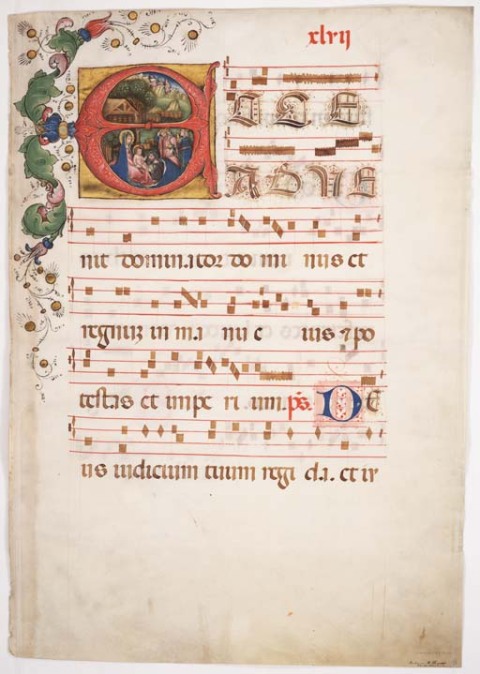St. Augustine, August 28
May 18, 2009
Leaf from an Antiphonary: Initial L with St. Augustine blessing three acolytes
Germany–Regensburg, ca. 1300
Script: Gothic
Parchment with ink, paint, and gold
Notation: Square
Begins the first antiphon of first Vespers for the feast of St. Augustine (Aug. 28), “Letare, mater nostra ierusalem …” (Rejoice, our Mother Jerusalem). Augustine of Hippo (354-430) was a Doctor of the Church and became Bishop of Hippo in North Africa in 396. His writings include Confessions and City of God and have dominated Western Christian theology since his lifetime. This leaf can be dated to ca. 1300-1310.
Free Library of Philadelphia, Lewis E M 42:13
Feast of St. John the Apostle, December 27
May 18, 2009
Antiphonary, Dominican use: Feast of St. John the Apostle, December 27
France, early 14th century
Script: Gothic bookhand (part one); Rotunda semitextualis (part two)
Parchment with ink and paint
Notation: Square
This antiphonary was made in France and eventually made its way to Italy by the 16th century, as there are added chants at the end of the volume which can clearly be dated to Italy in that time period.
This decorated initial U begins the response for the first nocturn of Matins for the Feast of St. John the Apostle, Dec. 27: “Valde honorandus est beatus iohannes qui supra pectus domini in cena recubuit. . .” (Very highly we must venerate blessed John; for during the Last Supper he reclined on the breast of the Lord). The page has been mended with green thread, possibly in the 18th or 19th century. This entire volume was well-used and well-worn, as it has mendings throughout, in addition to rips and tears from use.
Free Library of Philadelphia Lewis E 6 f158v
St. John the Baptist, June 24
May 7, 2009
Processional: Miniature depicting the Feast of St. John the Baptist, June 24
Paris, France, c. 1510
Script: Gothic bookhand
Parchment with ink, paint, and gold
Notation: Square
Although this processional is from the early Renaissance period, it was considered for some time to be from the medieval period, owing to its style and decoration. A processional is a personal book containing the appropriate music for liturgical processions. This book is made of fine French vellum, and is a handsome specimen: it is decorated throughout with insects, birds, and frogs, and was made for use at the Dominican house in Poissy, France.
This miniature shows St. John the Baptist, accompanied by his attribute, the Lamb of God, holding a Christian flag in its mouth. John the Baptist is usually recognizable in medieval art by his shaggy clothing and wild hair, which is meant to remind the medieval viewer of John’s humble lifestyle.
Free Library of Philadelphia Lewis E 7, f101v
Mary Magdalene, July 22
May 5, 2009

Gradual: Initial G with St. Mary Magdalene
Italy, ca. 1425
Script: Rotunda
Parchment with ink, paint, and gold
Notation: Square
This gradual is a shared book, and is enormous owing to the need of the choir to see it from a distance. A gradual contains the music needed for the Mass.
This historiated initial G begins the Introit for the Feast of St. Mary Magdalene (July 22), “Gaudeamus omnes in Domino diem festum celebrantes sub honore Mariae Magdalene…” (Let us all rejoice in the Lord celebrating the feast in honor of Mary Magdalene). According to The Golden Legend, Mary retired to the wilderness after the ascension of Christ, and each day was borne aloft by angels at the seven canonical hours so that she could hear the heavenly hosts. The angels appear in this historiated initial, as does the foliage of the wilderness. The long hair pictured here can be attributed to its status as part of her iconography: Mary washes Jesus’ feet with her tears in penitence and dries them with her long hair. There is also a legend of 11th-century origin that Mary’s hair miraculously grows to cover her nakedness when she goes into the desert as a penitent.
Free Library of Philadelphia, Lewis E 73
Assumption of the Virgin, Aug. 15
May 5, 2009
Initial G with the Coronation of the Virgin Mary, August 15
Perugia, Italy – c. 1325
Script: Rotunda
Parchment with ink, paint, and gold
Notation: Square
This initial begins the Introit for the feast of the Assumption of the Virgin, “Gaudeamus omnes in domino diem festi celebrantes sub honore Marie virginis …” (Let all rejoice in the Lord, celebrating a festival day in honor of the Virgin Mary). The image of Mary being crowned by her son Jesus Christ as Queen of Heaven or physically being assumed into heaven is a popular scene from the Middle Ages. The end of Mary’s days is frequently used as the image seen for Compline, the final hour in the Little Hours of the Virgin seen in medieval books of hours.
Free Library of Philadelphia E M 72:16









